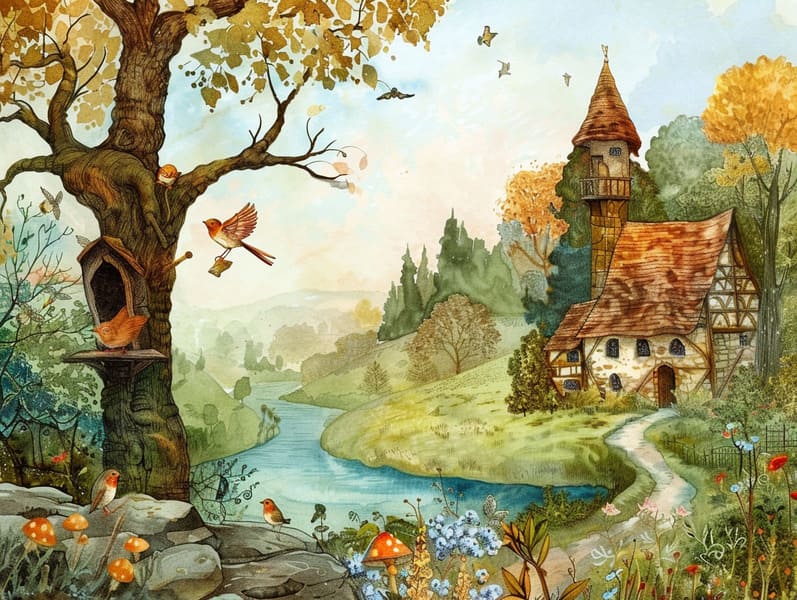
Ancient fairy tales have legendary status. These narratives have been passed down from one generation to the next well before they were ever put on paper. They came from a variety of civilizations, including European traditions. They were initially conveyed among elders, often carrying themes and messages pertaining to the societal norms and beliefs of the time.
The Brothers Grimm, Jacob and Wilhelm Grimm, were among the first to compile and release many of these beloved stories. Their published works, "Grimm's Fairy Stories," included narratives like "Cinder Maid," "Hansel and Grethel," and "The True Story of Snow White," which have since become essentials in the world of famous fairy tales. Similarly, Andersen's whimsical tales, such as "The Mermaid," and "The Little Duckling," have enchanted hearts worldwide, establishing their place in the pantheon of beloved fairy tales.
Despite their age, these tales remain as meaningful as ever, especially as kids' bedtime tales. These whimsical stories are now available in numerous formats, including beautifully illustrated books, delightful animations, and online storybooks.
Their ongoing significance can be traced to several delightful features:
Significant Morals: Old fairy tales often impart important moral lessons. Narratives like "The Boy Who Cried Wolf" teach the benefit of integrity, while "The Tortoise and the Hare" emphasize the traits of persistence and unassuming nature. These narratives offer kids clear distinctions between truth and falsehood, developing their moral compass in a tender yet profound way.
Sympathy and Perception: Fairy tales frequently depict personalities facing trials and tribulations, stimulating young listeners to identify with their struggles and celebrate their triumphs. For instance, "Beauty and the Beast" illustrates the benefit of looking deeper to understand the inner spirit of a character, strengthening warmth and discernment.
Cultural Comprehension: Many classic fairy tales are saturated in the cultural contexts from which they developed. Immersing in these tales can provide illuminating insights into different beliefs, enhancing a sense of world insight and understanding.
Fantasy and Imagination: The imaginative elements in classic fairy tales—mythical entities—unleash children’s innovative ideas. These fairy tales take readers to imaginary realms, unleashing creative thinking and a sense of marvel that endures a lifetime.
Timeless fairy tales are not only enchanting but also didactic. They serve as entrancing tools in strengthening various cognitive and affective skills in young ones. When classic fairy tales get more info are recited, they cultivate linguistic abilities by teaching new terms and intricate sentence structures. This practice also nurtures hearing perception and focus, as the young focus on every detail, eager to see what happens next.
Furthermore, analyzing the themes and characters of old fairy tales can nurture evaluative skills and critical thinking. Young ones are guided to detect patterns, forecast, and figure out cause and effect. These reflections also contribute to young ones convey their thoughts and feelings, promoting their emotional intelligence.
In today’s technological age, the abundance of internet fairy tales has made these narratives more obtainable than ever. Online resources and digital apps offer large libraries of timeless fairy tales that can be accessed or listened on anytime, anywhere. Fairy tales recited are particularly well-liked, extending an engaging way for little ones to relish these spellbinding stories. Audiobooks and narrated videos take characters and settings to life, often accompanied by charming soundtracks and musical scores that enrich the story journey.
The lasting appeal of ancient fairy tales lies in their ability to adjust to changing times while preserving their essential themes. Contemporary retellings of these stories often feature more multicultural figures and modern settings, making them pertinent to today’s audience. However, the basic principles of heroism, warmth, and even-handedness remain unchanged, continuing to resonate with kids of all ages.
Old fairy tales also offer a sense of contentment and knownness. They bestow a systematic narrative with a transparent beginning, middle, and end, often ending with the culmination of conflicts and the triumph of goodness over badness. This constancy can be soothing for young readers, distributing a sense of sturdiness in an constantly changing world.
Timeless fairy tales continue to fascinate and guide new generations, maintaining their magic and pertinence in modern society. As nighttime stories for kids, they yield a perfect blend of magic and knowledge, nourishing moral values, empathy, and creativity. The accessibility of online fairy tales and the in demand status of fairy tales voiced certify that these traditional stories remain attainable to new generations.
By protecting and releasing these narratives, we continue to esteem the rich tapestry of tradition and cultural heritage. Whether you are enjoying a vividly illustrated book, viewing a virtual library, or listening through an audiobook, the wonder of classic fairy tales is always within reach. These tales point out of the consistent impact of stories and its ability to link us across epochs and places.
Even if you are enjoying a gorgeously illustrated book, browsing a electronic collection, or listening on an sound book, the enchantment of famous fairy tales is always within reach.
These fairy tales convey of the steadfast power of narratives and its ability to unify us across time and space, forging a link that fascinates and enlightens alike.